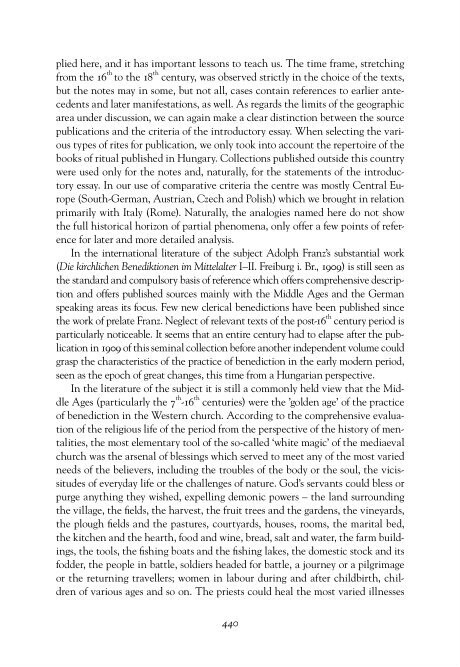
Page 441 [441]

OCR
plied here, and it has important lessons to teach us. The time frame, stretching from the 16" to the 18" century, was observed strictly in the choice of the texts, but the notes may in some, but not all, cases contain references to earlier antecedents and later manifestations, as well. As regards the limits of the geographic area under discussion, we can again make a clear distinction between the source publications and the criteria of the introductory essay. When selecting the various types of rites for publication, we only took into account the repertoire of the books of ritual published in Hungary. Collections published outside this country were used only for the notes and, naturally, for the statements of the introductory essay. In our use of comparative criteria the centre was mostly Central Europe (South-German, Austrian, Czech and Polish) which we brought in relation primarily with Italy (Rome). Naturally, the analogies named here do not show the full historical horizon of partial phenomena, only offer a few points of reference for later and more detailed analysis. In the international literature of the subject Adolph Franz’s substantial work (Die kirchlichen Benediktionen im Mittelalter J-II. Freiburg i. Br., 1909) is still seen as the standard and compulsory basis of reference which offers comprehensive description and offers published sources mainly with the Middle Ages and the German speaking areas its focus. Few new clerical benedictions have been published since the work of prelate Franz. Neglect of relevant texts of the post-16"" century period is particularly noticeable. It seems that an entire century had to elapse after the publication in 1909 of this seminal collection before another independent volume could grasp the characteristics of the practice of benediction in the early modern period, seen as the epoch of great changes, this time from a Hungarian perspective. In the literature of the subject it is still a commonly held view that the Middle Ages (particularly the 7'"-16" centuries) were the golden age’ of the practice of benediction in the Western church. According to the comprehensive evaluation of the religious life of the period from the perspective of the history of mentalities, the most elementary tool of the so-called ‘white magic’ of the mediaeval church was the arsenal of blessings which served to meet any of the most varied needs of the believers, including the troubles of the body or the soul, the vicissitudes of everyday life or the challenges of nature. God’s servants could bless or purge anything they wished, expelling demonic powers — the land surrounding the village, the fields, the harvest, the fruit trees and the gardens, the vineyards, the plough fields and the pastures, courtyards, houses, rooms, the marital bed, the kitchen and the hearth, food and wine, bread, salt and water, the farm buildings, the tools, the fishing boats and the fishing lakes, the domestic stock and its fodder, the people in battle, soldiers headed for battle, a journey or a pilgrimage or the returning travellers; women in labour during and after childbirth, children of various ages and so on. The priests could heal the most varied illnesses 440
structurelles
Custom
Image Metadata
- Largeur de l'image
- 1842 px
- Hauteur de l'image
- 2671 px
- Résolution de l'image
- 300 px/inch
- Taille du fichier d'origine
- 1.26 MB
- Lien permanent vers jpg
- 022_000006/0440.jpg
- Lien permanent vers OCR
- 022_000006/0440.ocr
